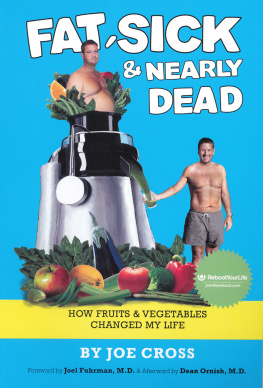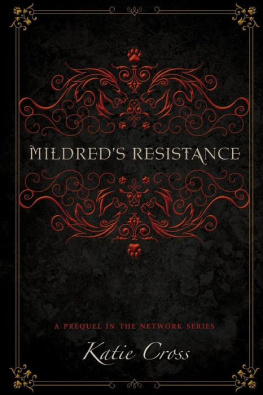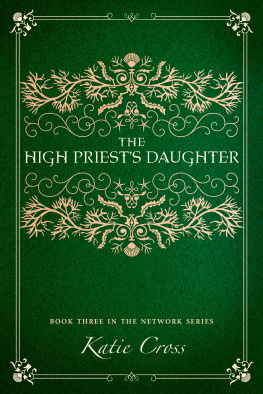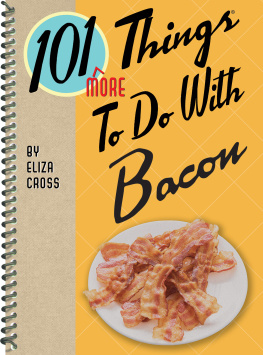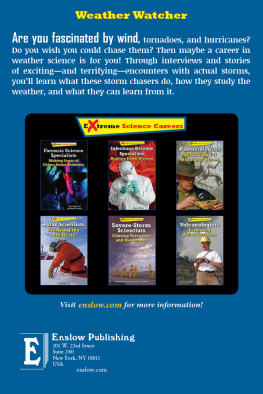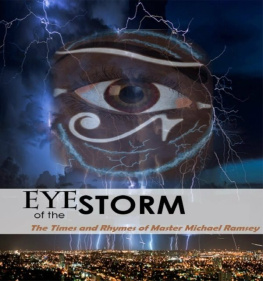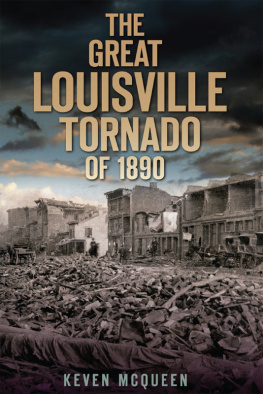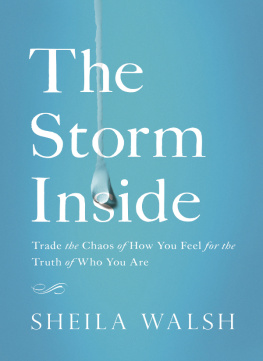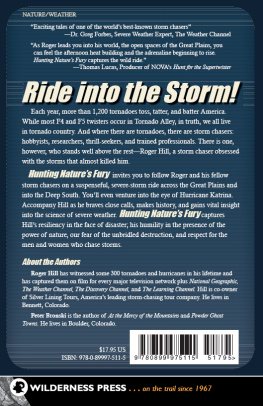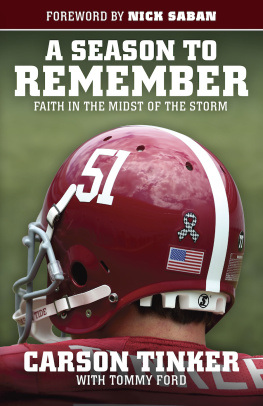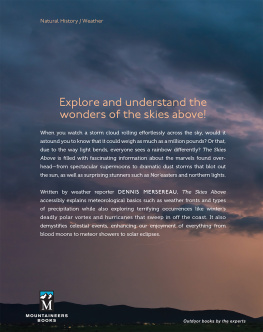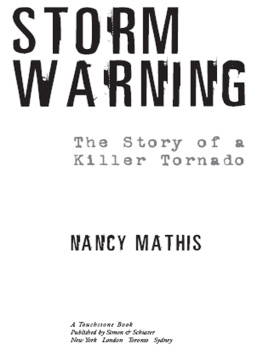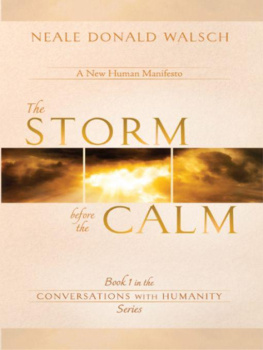Thank you for downloading this Atria Books eBook.
Join our mailing list and get updates on new releases, deals, bonus content and other great books from Atria Books and Simon & Schuster.
C LICK H ERE T O S IGN U P
or visit us online to sign up at
eBookNews.SimonandSchuster.com
We hope you enjoyed reading this Atria Books eBook.
Join our mailing list and get updates on new releases, deals, bonus content and other great books from Atria Books and Simon & Schuster.
C LICK H ERE T O S IGN U P
or visit us online to sign up at
eBookNews.SimonandSchuster.com
Praise for What Stands in a Storm
The writerly brilliancethe terse dark poetryof this debut book explodes from every page. Yet Kim Cross is too much of a writer to let mere masterful writing suffice. She has enlisted her sentences in the service of her tremendous reportorial mission: to recover and make sense of the thousands of fragmentary incidents, images, voices, and glimpses of human character ennobled by loss and imminent deaththe sum and substance of the most catastrophic mass-tornado attack in recorded American history. This young writer has done the impossible: she has out-written apocalypse. A new star has appeared in our literary sky.
Ron Powers, Pulitzer Prizewinning journalist and coauthor of Flags of Our Fathers
Amid so much terror and pain and death, there is an overflowing of life here in What Stands in a Storm , gathered together in a blessing of uncommon decency and indelible beauty. If you want to know what shape your hearts in, read this book and learn, through Kim Crosss extraordinary reportage and artistry, that stories are as much a gift as life itself. Stories, in fact, are our afterlife.
Bob Shacochis, author of The Woman Who Lost Her Soul
Whether you live in tornado country or not, everyone should read this book. Heartbreaking and heroic.
Fannie Flagg, author of Fried Green Tomatoes at the Whistlestop Cafe
Turn off your cell phone. Call in sick. Tell your family whatever you need to tell them, because youre going to have to have eight hours of uninterrupted time once you begin Kim Crosss book. Her verbs pulsate, her narrative web sucks you in. Mostly, Cross makes you care about the people in What Stands in a Storm , their quirks and aspirations. You wont look at a coiling sky the same way after reading this powerhouse debut.
Beth Macy, New York Times bestselling author of Factory Man
What Stands in a Storm is a dramatic and carefully reconstructed account of natures unexpected and explosive power and the strength of humans to bond together in its destructive wake.
Peter Stark, author of Astoria and The Last Empty Places
With exhaustive, on-the-ground reporting, spellbinding prose and voices of the living and the dead recounting every haunting moment of the storms three-day reign of terror, Kim Cross has produced a spine-chilling narrative. What Stands in a Storm will tear apart, forever, our complacent sense of security when we look at a dark sky overhead.
George Getschow, writer-in-residence, The Mayborn Literary Nonfiction Conference
A powerful book, unforgettable in its recreation of a horror that swallowed entire communities. Kim Cross brings to life the soul-searing experience of people standing prostrate as a monstrous storm tears their lives to shreds. But there is joy in this horror. She shows us how ordinary people in the worst-hit areas discovered what they and their communities were made of as the sky fell around them.
Winston Groom, author of Forrest Gump
For those who lost their lives to this, and for everyone who loved them
CONTENTS
AUTHORS NOTE
April 27, 2011, became the deadliest day of the biggest tornado outbreak in the history of recorded weather. It was the climax of a superstorm that unleashed terror upon twenty-one statesfrom Texas to New Yorkin three days, seven hours, and eighteen minutes. Entire communities were flattened, whole neighborhoods erased, in seconds, by the wind.
This was an epic storm in an epic month: April 2011 saw three separate outbreaks and a record 757 tornadoesnearly half of which (349) occurred during the April 2427 outbreak that inspired this book. This anomalously stormy month blew away the previous April record of 267 tornadoes in April 1974 (and the record for any month, topping the May 2004 count of 542).
The storm left in its wake long scars across the landscape, $11 billion in damage, and at least 324 people dead. Most of them died in Alabama, which now leads the nation in tornado deaths. On April 27, a total of 62 tornadoes raked the state; in some moments, there were six or more on the ground at once.
This book tells the story of this storm through the characters who lived it. All the characters and events in this book are real, based on more than a year of research and one-hundred-plus hours of interviews with responders, meteorologists, survivors, and the families of those who died.
Any dialogue in quotation marks was taken directly from an audio or video recording, or from transcribed interviews in which those conversations were recounted directly to me. Time-stamped posts were recorded directly from Facebook, Twitter, and chat rooms. Text conversations were retrieved from victims salvaged phones and shared with me by their families. These conversations have been left raw and intact, with no editing for grammar, spelling, or punctuation. Emergency radio transmissions were transcribed from time-stamped recordings. A persons thoughts set in italics were based on social media posts by that person, or were remembered by primary sources present when the character said what they were thinking.
I have attempted to check and double-check my scientific facts with the help of many experts, including respected research and forecast meteorologists and a fact-checker trained in science writing. That said, any errors are mine.
FOREWORD
Almost nothing stood.
Where the awful winds bore down, massive oaks, one hundred years old, were shoved over like stems of grass, and great pines, as big around as fifty-five-gallon drums, snapped like sticks. Church sanctuaries, built on the rock of ages, tumbled into random piles of brick. Houses, echoing with the footfalls of generations, came apart, and blew away like paper. Whole communities, carefully planned, splintered into chaos. Restaurants and supermarkets, gas stations and corner stores, all disintegrated; glass storefronts scattered like diamonds on black asphalt. It was as if the very curve of the earth was altered, horizons erased altogether, the landscape so ruined and unfamiliar that those who ran from this thing, some of them, could not find their way home.
We are accustomed to storms, here where the cool air drifts south to collide with the warm, rising damp from the Gulf, where black clouds roil and spin and unleash hell on earth. But this was different. A gothic monster off the scale of our experience and even our imagination, a thing of freakish size and power that tore through state after state and heart after Southern heart, killing hundreds, hurting thousands, even affecting, perhaps forever, how we look at the sky.
But that same geography that left us in the path of this destruction also created, across generations, a way of life that would not come to pieces inside that storm, nailed together from old-fashioned things like human kindness, courage, utter selflessness, and, yes, defiance, even standing inside a roofless house.
As Southerners, we know a man with a chain saw is worth ten with a clipboard, that there is no hurt in this world, even in the storm of the century, that cannot be comforted with a casserole, and that faith, in the hereafter or in neighbors who help you through the here and now, cannot be knocked down.
Next page


